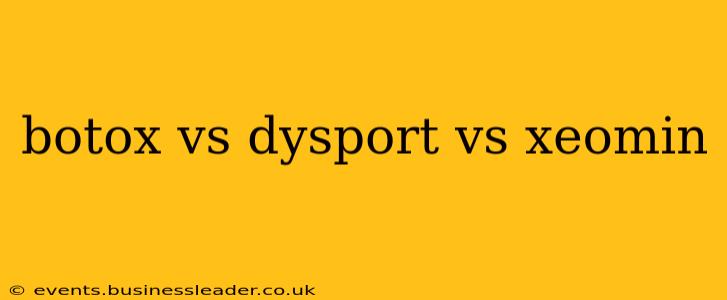Choosing between Botox, Dysport, and Xeomin can feel overwhelming. These three neurotoxins all work to temporarily relax facial muscles, reducing the appearance of wrinkles, but they have subtle differences that can impact the results you see. This comprehensive guide will delve into the specifics of each, helping you make an informed decision.
What are Botox, Dysport, and Xeomin?
Botox, Dysport, and Xeomin are all FDA-approved injectables containing botulinum toxin, a purified protein that temporarily blocks nerve signals to muscles, causing them to relax. This reduction in muscle activity smooths out wrinkles and fine lines, giving the skin a more youthful appearance. While they achieve similar results, the specific types of botulinum toxin they contain and their molecular structures differ slightly, leading to variations in their effects.
How do Botox, Dysport, and Xeomin differ?
The key differences lie in the type of botulinum toxin used, the spread of the injection, and the onset and duration of results.
-
Botox (OnabotulinumtoxinA): Botox is the original and most widely known brand name. It's known for its precise targeting and longer duration of effects in some individuals. It tends to work best in the glabellar lines (between the eyebrows) and forehead.
-
Dysport (AbobotulinumtoxinA): Dysport is known for its wider spread of action. This means that a smaller amount might be needed to cover a larger area, potentially leading to a slightly faster onset of action. Many find that Dysport is ideal for treating crow's feet and the upper lip area.
-
Xeomin (IncobotulinumtoxinA): Xeomin is considered a "pure" botulinum toxin, lacking the complexing proteins found in Botox and Dysport. Some believe this may lead to a reduced risk of antibody formation, although further research is needed to fully confirm this. It also offers a potentially longer duration of effects for some patients.
What is the onset of action for each treatment?
The onset of effects varies slightly among individuals and depends on factors like metabolism and the treatment area, but generally:
- Botox: Effects usually become noticeable within 2-3 days, with full results seen within 7-14 days.
- Dysport: Often shows visible results more quickly, usually within 24-48 hours, with full effects appearing within 7-10 days.
- Xeomin: Similar to Botox, effects typically appear within 2-3 days, with peak effects at around 7-10 days.
How long do the effects of each neurotoxin last?
The duration of results also varies based on individual factors and treatment area:
- Botox: Effects typically last 3-4 months.
- Dysport: Similar to Botox, results commonly last 3-4 months.
- Xeomin: The duration is comparable to Botox and Dysport, generally lasting 3-4 months.
Which neurotoxin is best for treating specific areas?
While all three can treat various areas, some may be better suited for certain zones:
- Glabellar lines (between the eyebrows): Botox is often preferred for its precise action.
- Crow's feet (around the eyes): Dysport's wider spread can be advantageous.
- Forehead lines: Both Botox and Dysport are commonly used.
- Neck bands: All three can be used, with the choice often based on individual responses.
Which Neurotoxin is Right for Me?
Ultimately, the best neurotoxin for you depends on individual factors like your specific concerns, desired outcome, and your body's response to the treatment. A consultation with a qualified and experienced dermatologist or plastic surgeon is crucial. They can assess your facial features, discuss your goals, and recommend the best option based on your unique needs. Don't hesitate to ask about their experience with each neurotoxin and the types of results they typically achieve.
What are the potential side effects of Botox, Dysport, and Xeomin?
Possible side effects are generally mild and temporary and include:
- Bruising or swelling at the injection site
- Headache
- Flu-like symptoms
- Muscle weakness in the treated area (though rare)
Remember to always choose a board-certified physician for any cosmetic procedures. They can properly assess your medical history and ensure the procedure is safe and appropriate for you.
